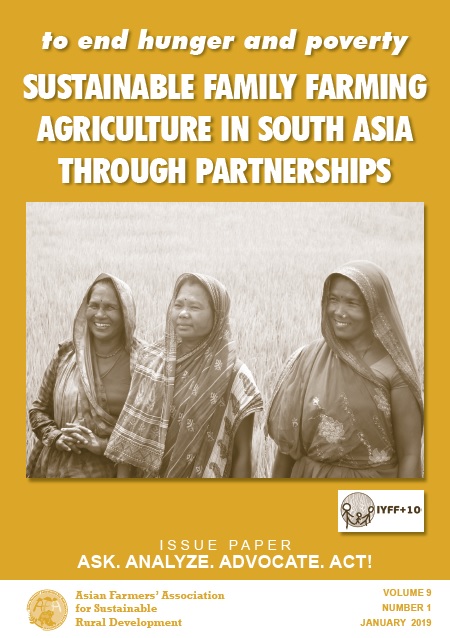DOWNLOAD: Sustainable_Family_Farming_Agriculture_in_South_Asia_through_Partnerships
South Asia, comprised of Afghanistan, Bangladesh, Bhutan, India, Maldives, Nepal, Pakistan and Sri Lanka, is home to about 1.8 billion people — nearly 25% of the world’s population.1 But with an area of 5.2 million square kilometers, or some 1% of the world’s area, South Asia is the most densely populated region in the world.2 Moreover, despite yielding a Gross Domestic Product (GDP) of US$ 3.3 trillion and Gross National Index (GNI) per capita of US$1.7 billion in 2017,3 South Asia is the world’s hungriest region with a Global Hunger Index score of 30.5.4 The region shelters 22% of the world’s undernourished. Around 282 million South Asians live below the poverty line, and most of them reside in rural areas.
In the face of extreme poverty and hunger, and amidst a wide disparity of wealth, the region rightfully pins its hopes on agriculture.
About 57 percent of South Asia is arable or agricultural land. Nearly 60 percent of South Asia’s population is engaged in agriculture.
However, the challenges of an increasing population and rising economic growth are straining the agriculture sector as it struggles to meet the present and future demand for food, to sustain both the people’s nutrition and economic development. Aggravating the matter are the region’s inefficient use of inputs such as water and fertilizer, and deteriorating natural resources that have led to declining crop yields and waning profitability. Rising food prices, inconsistent domestic and trade policies, and weakened agricultural institutions further intensify this agrarian crisis.
Climate change exacerbates the problem. Much of the agriculture in South Asia is rain-fed, so there is a fundamental dependence on rains that come seasonally. The probability of lower crop yields can thus increase with climate change. Much of the agricultural production in the region is undertaken by smallholders, on very small landholdings, by women, with a significant dependence on fisheries for protein in several countries, and dependence on livestock for draft power, manure, milk, and food security. Smallholders are the most vulnerable in the face of climate change, as their ability to bear risk is extremely low.
Women play a significant role in agriculture, including in the production of high-value crops such as vegetables; home garden cultivation; and in the raising of animals. For example, in India, the agriculture sector employs 4/5 of all economically active women in the country and 48% of self-employed farmers are women. In Sri Lanka, 41.5% of women work in agriculture; in Bhutan, the figure is 62%.
A Breakthrough in Partnerships
The South Asian Association for Regional Cooperation (SAARC) is the regional intergovernmental organization of nations in South Asia. At the first SAARC Summit in Dhaka in 1985, the South Asian Heads of State or Government adopted the Charter establishing the SAARC. SAARC Secretariat is based in Kathmandu, Nepal.
SAARC has implemented programs and formulated policies that span issues of agriculture and rural development, economics and trade, social affairs, information, poverty alleviation, energy, transport, science and technology, education, environment, natural disasters, biotechnology, human resource development, tourism, and a host of other concerns in efforts to promote the welfare of the peoples of South Asia, which improve their quality of life, as well as actions that accelerate economic growth, social progress and cultural development in the region.





Comments are closed